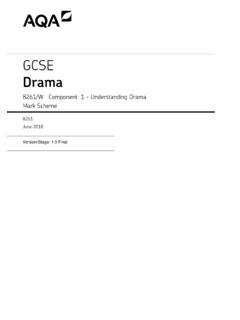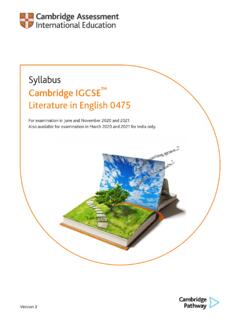Transcription of GCSE Guide to Devising - Edexcel
1 1 A Guide to Devising at gcse Contents 1. What is Devising ? 2 2. Choosing a stimulus 2 3. Researching the stimulus 4 4. Establishing aims and objectives 5 5. Practical exploration 6 6. Discovering genre, style and form 13 7. Developing structure 16 8. Refining the performance 18 9. Rehearsing the performance 19 10. Previewing the performance 19 2 1. What is Devising ? Devising is a group collaboration in response to a stimulus leading to the creation of an original performance. Devising in drama demands inventiveness, an understanding of the rules of structuring a piece of theatre and a readiness to collaborate with others. There is no restriction on the chosen style of the devised piece; however, the teacher should ensure that the style provides all group members with the opportunity to access the marking criteria.
2 The teacher can select any stimulus (for this specification this this should not be a play text), or any combination of stimuli: an image, a text (such as a poem, story or piece of non-fiction), an object or a piece of music, for example . From here the possibilities are endless. Groups must work collaboratively to generate the devised performance and to challenge each other to develop creative ways of using voice, movement and space. The form and content of the devised work may reflect the group's awareness of their chosen social, historical, political and cultural context. Consequently, the students' experiences of live productions, workshops and research will be crucial to their creative successes.
3 A successful devised performance reflects a disciplined attitude towards editing and structuring that allows the intentions of the group s creative piece to be clearly communicated to an audience. With this component students will be aiming to mirror professional work in practice as closely as possible, they will use their portfolio to record their creating process as they progress just as would happen in a professional rehearsal room. Devising must not be seen as separate from the other experiences on the gcse course. Students should be encouraged to realise that every activity and experience can impact upon devised work. For example , they may be intrigued by a character in a play they have seen or interested in a piece of music played during a lesson; an exercise used to study a text could be adapted to explore ideas.
4 There are many possible starting points for Devising , which some students will be able to identify and develop into a successful performance. However, many students need support and direction to be able to achieve high standards in both performance and portfolio. The aim of this Guide is to propose a clear direction in Devising ; however, it is in no way prescriptive. 2. Choosing a stimulus The gcse drama specification says: Teachers should choose between 1 3 pieces of stimuli and these may be one or a combination of the following: textual, for example a novel, poem, story, letter or factual material (for this specification play texts are not permitted) visual, for example a painting, photograph, film or artefact aural, for example a piece of music, a soundscape or a recording abstract, for example a word, a theme or a mood.
5 The choice of stimulus is for you to decide. It is important that the chosen stimulus captures and maintains the interest of the group for the duration of the devised project. The Devising component is worth 40% of the gcse course and as part of the project, students should have time to create and 3 develop ideas, as well as time for rehearsals, performance and completion of the portfolio. It is recommended that you start looking at stimuli within the personal realm of the students and gradually expand the search until appropriate stimuli are found. The choice of stimulus could be the first step of Devising for students, and involving them in this choice encourages their engagement throughout the process.
6 Alternatively, you can use a teacher-chosen stimulus if you feel this may give students a more successful start. However, it is important that students can demonstrate in their portfolio how the stimulus inspired their ideas for the final performance. Possible stimuli: Personal experience: Stream of consciousness biography Five best life experiences Five worst life experiences An object from home that is significant Society: Stories in local newspapers/on websites Issues that are pertinent to the local community Photographs of locations in the town Descriptions of places that make them feel scared A particular audience/group of people Culture: Short/feature films Documentaries Music Lyrics Poetry Novels Children's books Art paintings, photography, installations Personal Experience SocietyCulture PoliticsHistory4 Political.
7 Accounts of people affected by different political systems Revolutionary ideas Responses to the question What is politics? Political figures Definition of left-wing/right-wing History: Historical events Historical figures Family histories Theatre history Once the stimulus has been decided, the first part of the process should be a free for all discussion and the recording of initial responses. It would be a good idea for notes to be recorded in a written or audio/visual format, to support the development of the portfolio. 3. Researching the stimulus At this stage in the process it is crucial for students to take ownership of the material they are developing. They must come to understand that if the material is exciting and interesting for them then it is more likely to engage their audience.
8 This will only be achieved when research and practical exploration run concurrently. Students sometimes find research frustrating, as a quick look on a search engine does not necessarily reap instant rewards. Support with and modelling of the research process is therefore essential for this stage of Devising at gcse level. In particular, students need to develop the skill of making connections between their research material and the piece they are Devising . Encourage them to think about their ideas constantly, imagining the possibilities and being adventurous in creating possible storylines. The benefits of thinking time can be overlooked, so encourage students to utilise any spare moment to wonder and imagine the possibilities of their devised work.
9 The group dynamic is a real strength of this type of work. Teachers should harness the different thinking styles of their students and encourage them to explore every avenue. There are various sources when carrying out research: Internet Library Departments and teachers within the school Art and photography books Music News print, television, internet Theatre programmes/images/recordings. These could be used by all members of the group or given as individual, independent research avenues, for students to share research findings later. The research process does not need to be over complicated. The students simply take the words and ideas identified during the initial response to the 5 stimulus and begin finding connections within these different avenues.
10 Every connection is valid and should be recorded. It is essential to keep records of the research, so it can be shared and fed back to other group members and form part of a student s final portfolio. Students will find individual folders or notebooks extremely useful when selecting the significant moments of development to be included in their portfolios. Students may also want to have a shared computer file where they can keep music recordings, video footage and images gathered. The research stage requires time at the start of the project before practical explorations begins. The practical work can begin as soon as substantial ideas have been developed, but research should remain an on-going element throughout the process, as it will help to keep students work fresh and detailed.













